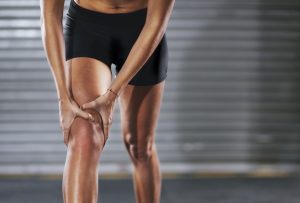The knee is one of our most critical joints for walking and playing sports, but it is also highly vulnerable. As a  hinge joint, the knee is meant only to move in one direction. Blows from the front or sides, twisting and other movements can cause stretching or tearing of the knee ligaments. Understanding the anatomy of the knee can help you understand the origin of common knee injuries and how to avoid them.
hinge joint, the knee is meant only to move in one direction. Blows from the front or sides, twisting and other movements can cause stretching or tearing of the knee ligaments. Understanding the anatomy of the knee can help you understand the origin of common knee injuries and how to avoid them.
Anatomy of the Knee
A ligament is made up of highly fibrous connective tissue. In the knee joint, the femur, or thigh bone, makes contact with the tibia, or shinbone. There is another small bone on the outside of your lower leg called the fibula, which also attaches to the femur. Finally, the patella, or kneecap, sits on top of the joint. All of these bones are attached via ligaments, which stabilize the joint. Injury to the ligament can be painful and may require the help of an orthopedic doctor.
Ligaments of the Knee
There are four major ligaments of the knee:
- Anterior cruciate ligament. The anterior cruciate ligament, or ACL, is located in the center of the knee toward the front. The ACL allows your tibia to rotate and generate forward motion. ACL injuries often occur when you suddenly twist.
- Posterior cruciate ligament. Like the ACL, the posterior cruciate ligament (PCL) is also located in the center of the knee. However, it connects to the back of the tibia, controlling the backward movement of this bone. PCL tears often result from a sudden, forceful blow to the knee.
- Medial collateral ligament. The medial collateral ligament, or MCL, runs along the inner side of the knee. It stabilizes the knee joint. The MCL is often torn or stretched when you receive a blow to the side of the knee.
- Lateral collateral ligament. The lateral collateral ligament, or LCL, runs along the outer side of the knee. LCL tears are less common but can occur with a blow to the inside of the knee.
Knee injuries are extraordinarily common, particularly among athletes. Being mindful of your body movements and avoiding jarring or twisting motions can help you avoid injury. If you do become injured, seek treatment immediately. Our sports medicine experts at Southeast Orthopedic Specialists can recommend treatment options that restore your range of motion as soon as possible.
Return to Blog